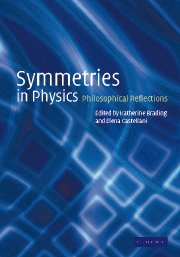Book contents
- Frontmatter
- Contents
- List of contributors
- Preface
- Copyright acknowledgements
- 1 Introduction
- Part I Continuous symmetries
- Part II Discrete symmetries
- Part III Symmetry breaking
- Part IV General interpretative issues
- 22 Classic texts: extracts from Wigner
- 23 Symmetry as a guide to superfluous theoretical structure
- 24 Notes on symmetries
- 25 Symmetry, objectivity, and design
- 26 Symmetry and equivalence
- Index
23 - Symmetry as a guide to superfluous theoretical structure
Published online by Cambridge University Press: 08 October 2009
- Frontmatter
- Contents
- List of contributors
- Preface
- Copyright acknowledgements
- 1 Introduction
- Part I Continuous symmetries
- Part II Discrete symmetries
- Part III Symmetry breaking
- Part IV General interpretative issues
- 22 Classic texts: extracts from Wigner
- 23 Symmetry as a guide to superfluous theoretical structure
- 24 Notes on symmetries
- 25 Symmetry, objectivity, and design
- 26 Symmetry and equivalence
- Index
Summary
Symmetries can be a potent guide for identifying superfluous theoretical structure. This topic provides a revealing illustration of the power of formal methods for illuminating the contents of our theories, and bears potentially on some very old philosophical problems. The philosophical and scientific literature contains a good many discussions of individual cases, but the treatment is rarely general and tends to be technically involved in a way that may bury the basic physical insight as well as making it inaccessible to philosophers. We wish to identify the sorts of symmetry that signal the presence of excess structure, and do so in a completely general way, applicable to all theories and all genres of theory.
What is superfluous structure?
For any entity whether concrete or abstract we distinguish its elements and its structure; the latter is specified by listing relations between the elements (equivalently, features of sets or sequences of elements). Whether or not some of its structure is superfluous is clearly an interest-relative question. A sowing machine has superfluous structure if some features of or relations between its elements are dispensable for sowing, although these may be quite relevant to it from an aesthetic or antique collectors' point of view. Each of two features may be dispensable for the given purpose, but they may not be both dispensable at once, namely if the machine has multiple features which can play each other's roles.
- Type
- Chapter
- Information
- Symmetries in PhysicsPhilosophical Reflections, pp. 371 - 392Publisher: Cambridge University PressPrint publication year: 2003
- 32
- Cited by

